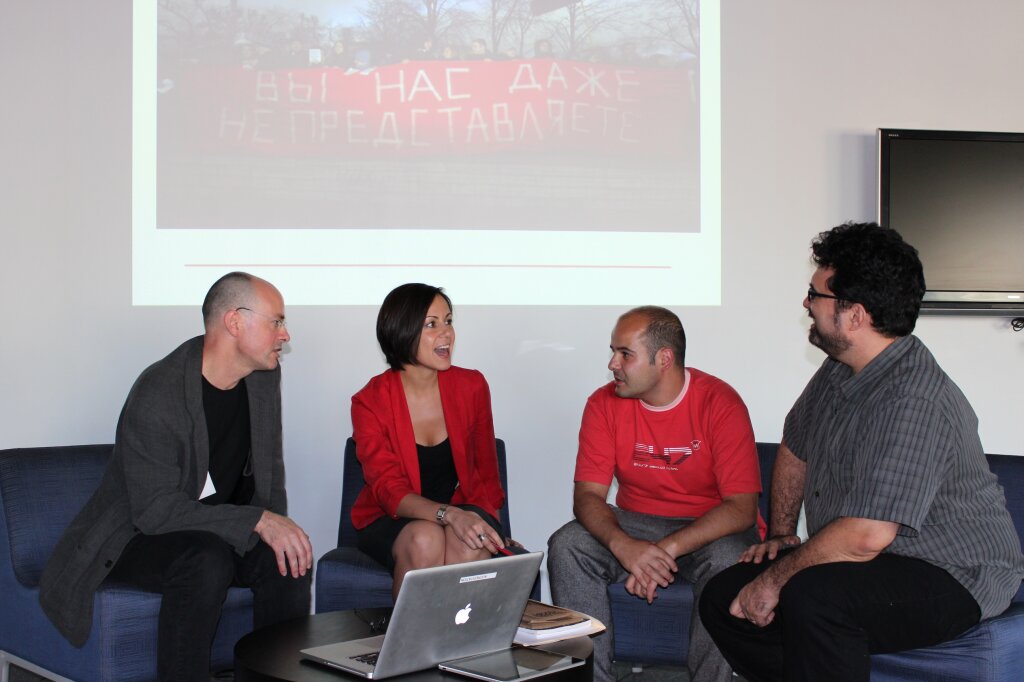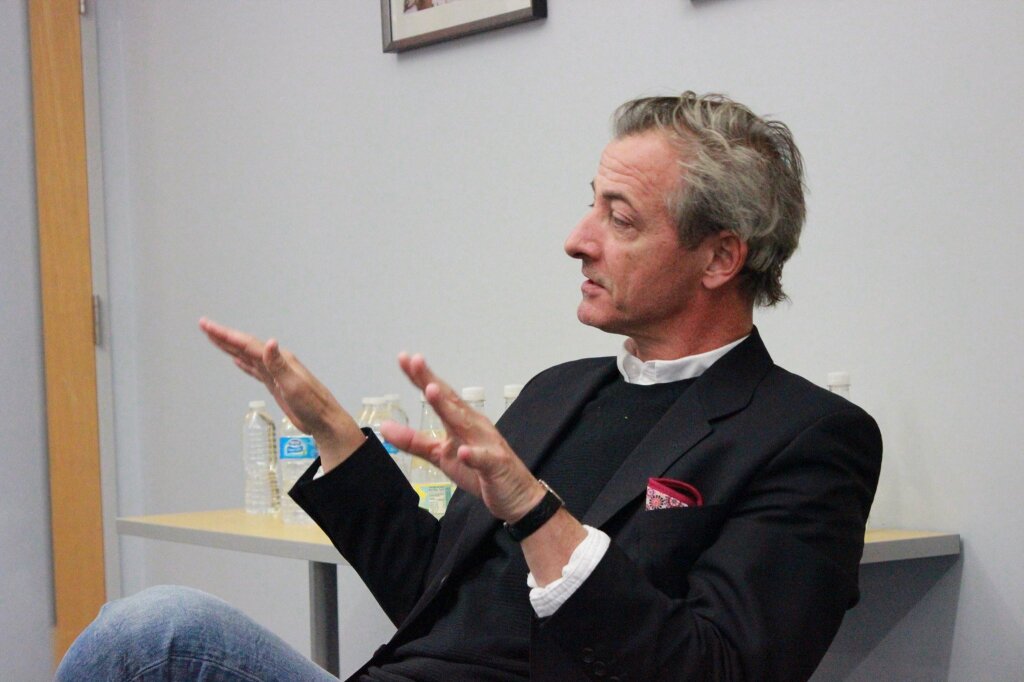On September 17, 2021, the Jordan Center hosted Michał Murawski for the talk “Falshfasad: Disavowed Infrastructure and Everyday Mate-realism in Wild Capitalist Moscow.” Murawski is a Lecturer in Critical Area Studies at the School of Slavonic and East European Studies at University College London. He is currently writing a book on architectural aesthetics and politics in Putin-era Moscow.
Murawski began the event by talking about “falshfasad” (the false facade) in Russia––particularly one that is signaled by green and white-striped covering used to block the views of construction that he says “connote an atmosphere of sensory pleasure and labor-free leisureliness.” The falshfasad is supposed to protect the viewer from the possibly ugly or uncomfortable spectacle on the other side, but since the falshfasad is used so often and for so long, it becomes dirty and covered in graffiti. The dirtied falshfasad “signals that someone or something is being veiled by it” and therefore draws attention to the construction rather than distracting the viewer from it.
Murawski’s talk focused on the roles that architecture plays in modern Russia, focusing mainly on Zaryadye Park in Moscow. Zaryadye Park, which was finished in 2017, is an incredibly modern and futuristic park that Murawski explained is more focused on spectacle than it is on infrastructure. Zaryadye attempts to combine spectacle and infrastructure, but leans much farther towards spectacle than anything else. Murawski claims that Zaryade and parks like it are two sides within a single space, “a territory on which polar opposites intersect.”
To some Muscovites, this park is an incredible spectacle where selfies are to be taken, especially on the “soaring bridge,” while to others, the park is a meaningless eyesore. They feel that the park does not “fit” or make sense in Moscow. It is simultaneously highly constructed and organic, perfectly fitting into the idea of two opposites intertwining, so it feels like it does not belong in the city. So much thought was put into the construction and aesthetics of the park and bridge that other very important aspects were forgotten––or purposefully left out. Murawski commented on how the bridge is highly inaccessible to people with strollers, wheelchairs, and just inaccessible in general to the disabled population. The ramps for wheelchairs are almost comically spaced apart and are therefore unusable, as if an afterthought. There are very few ramps and lifts overall, which acts almost to say that this aesthetic future is only for the able-bodied. This inaccessibility further alienates the park from the populace.
Zaryadye Park’s famous “soaring bridge” is a prime selfie spot as well. Murawski quoted architectural critic and ideologue Grigori Revzin, saying that these new structures “transform street into theatre” because when they are being built, their ability to create good photos and selfies is taken into account.
While some Muscovites see no use in the bridge, others say its uselessness is precisely the point. Murawski mentioned Timur Bashkaev, who took part in a debate responding to Dmitri Medvedev’s critique of the bridge as superfluous. Bashkaev leans into this criticism, saying that the bridge is not utilitarian and that is precisely the point. It is an attraction and nothing more. Murawski added that the “superstructure and spectacle are... programmatically prioritized over infrastructure and even access.”
These grand public parks, like Zaryadye and Manhattan’s Highline Park, are often lauded as gifts to the public. After the opening of Zaryadye, the news was filled with stories of the park's new visitors behaving wildly, trampling gardens, and trashing the park. This “gift rhetoric” happened as well with Highline Park. Murawski claims that these “private-public paradises” are “both power verticals masquerading as power horizontals betraying in their modi operandi family resemblance to the violent and chaotic wild capitalism of the Russian 1990s.”
At the close of his talk, Murawski made his way back to the falshfasad. Because of how widespread the green and white stripes were, they became sources of inspiration for artists and designers. The green and white falshfasads brings back memories of Potemkin villages. Murawski explained these green and white stripes arouse feelings of “a surface level feeling of order and prosperity thinly veiling a miserable and unsightly reality,” especially in conversation about Zaryadye. He went on to say that Zaryade is in fact an attempt at falshfasad itself.
On the other side of the falshfasad, in the gorodok, the builders and construction workers of Zaryade live in relative squalor compared to the paradise they have built, separated from the masses. Although they are paid poorly and on an irregular basis, they are prideful in their work. Though Murawski also quoted a security guard from western Russia who said that she didn't like the park and didn't understand the need for it, saying that it was for Muscovites and no one else.
Murawski ended his talk with mention of how discussions on either side of this topic are “saturated” with Marxist-Leninist theory and how this actually does have “critical purchase,” as he puts it, especially when talking about the worker-populace split by the falshfasad. The park is supposedly representing the Soviet Union without shortages–what could have been. The falshfasad delineates the unreality of paradise and of Russia, and the material and materialist reality of the gorodok. He ended the event by saying that vernacular Marxism “can be deployed to critique reality or express a desire to change it, but also in a strange hybrid of socialism and capitalist realism, in a Mark Fisher sense, to consolidate the illusion that, no matter whether paradise is real or not, there is no alternative to it.”
Watch the event recap on YouTube here.


